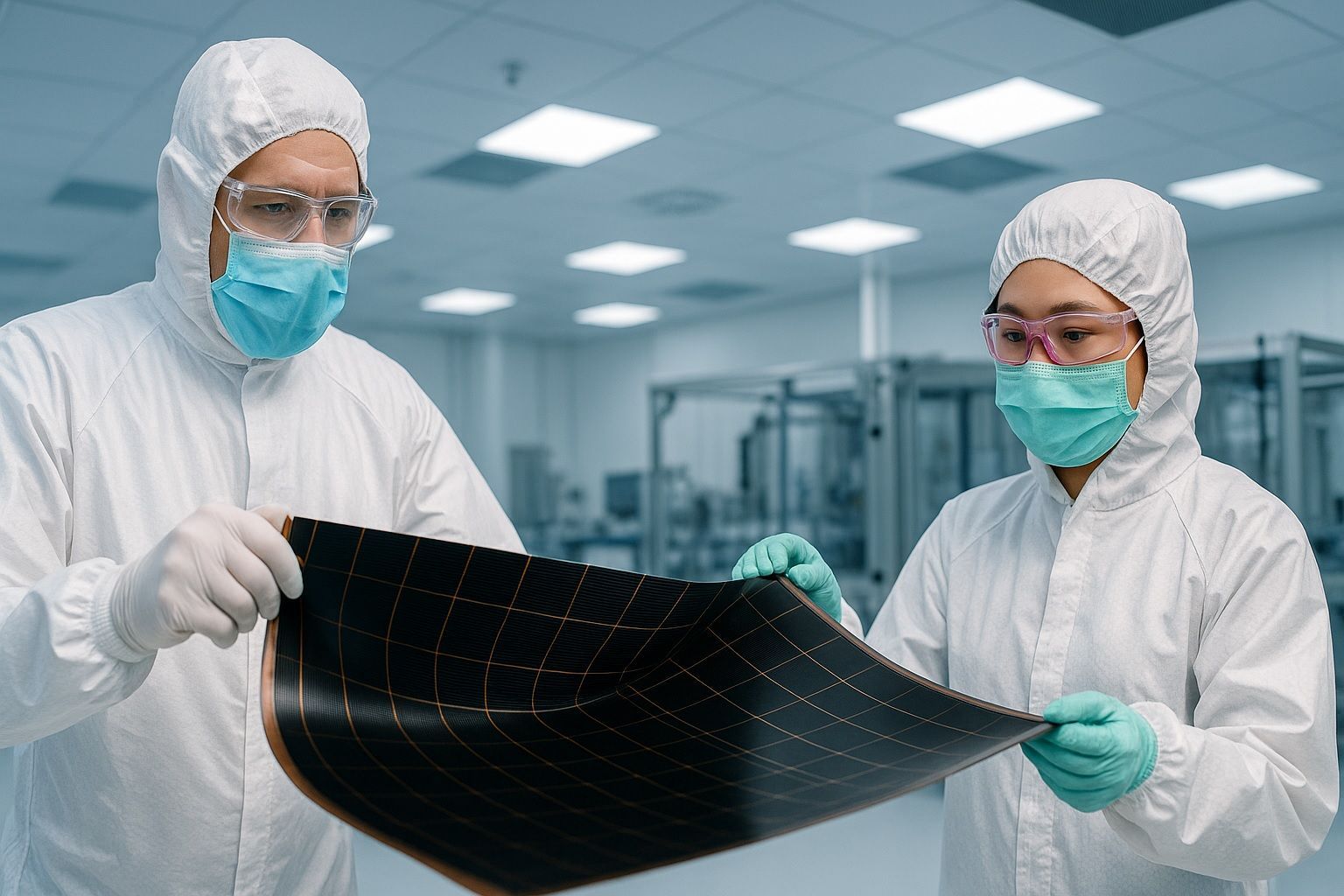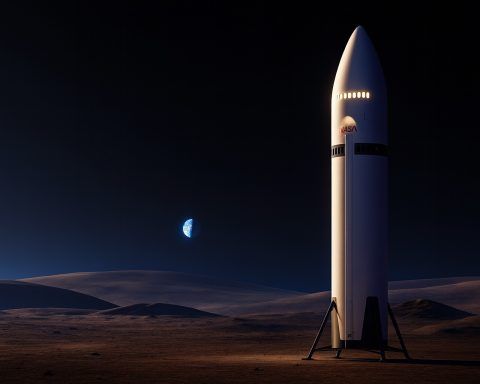- The space-based solar power (SBSP) concept was proposed in 1968 by Peter Glaser to place satellites in orbit and beam power to Earth.
- In 2023 Caltech’s Space Solar Power Demonstrator (SSPD-1) conducted three beaming tests in May, June, and July 2023 using the MAPLE flexible array to show ground reception of orbital power.
- In June 2025, Ascent Solar announced a 12-month Collaborative Agreement with NASA’s Marshall Space Flight Center (MSFC) and Glenn Research Center (GRC) to develop thin-film PV arrays for power beaming.
- Ascent’s copper-indium-gallium-selenide (CIGS) thin-film modules achieve about 15.7% production efficiency, with the Titan line targeting 17%+ efficiency and delivering roughly 17 watts from a panel the size of a sheet of paper weighing about 10 grams.
- Ascent’s CIGS solar sheets flew on NASA’s Psyche deep-space probe in 2023 to support a laser communications experiment and are slated to power upcoming lunar CLPS missions.
- The thin-film approach reduces solar-array mass by up to 90% and enables integration onto deployable blankets or curved surfaces, including roll-out solar sails.
- Beamed-power concepts aim to deliver energy at intensities equivalent to ten times ordinary sunlight, enabling up to an order-of-magnitude reduction in required array area and mass for the same power.
- NASA/Ascent project benefits include potential savings of tens of millions of dollars per lunar mission, with Earth-to-Moon delivery costs around $1–10 million per kilogram.
- End-to-end efficiency remains a major hurdle, with Caltech’s MAPLE results around 10^-11 and the Naval Research Laboratory reporting only 1.5 watts of beam power at about 11% efficiency in 2023 demonstrations.
- Safety, regulatory, and environmental considerations require international cooperation and large receiving farms (several square kilometers), plus careful beam-control and frequency-regulation measures.
Background: The Promise of Space-Based Solar Power (SBSP)
Space-based solar power (SBSP) is the ambitious concept of harvesting solar energy in space and beaming it down to Earth. The idea dates back to 1968, when engineer Peter Glaser first proposed placing giant satellites in orbit to collect sunlight and transmit power wirelessly to Earth [1]. In theory, SBSP could tap a virtually unlimited 24/7 supply of solar energy in orbit, free from weather or nightfall. Experts note that orbital solar panels could generate 8 times more power than the same area on Earth’s surface [2]. Unlike ground solar or wind farms that stop producing at night or in bad weather, space solar stations could deliver continuous clean energy day and night, potentially displacing fossil fuels and stabilizing grids [3].
Interest in SBSP has surged in recent years thanks to technological advances and the urgency of climate change. Advocates argue that modern robotics, more efficient wireless power transmission, and cheaper heavy-lift rockets like SpaceX’s Starship could finally make SBSP feasible [4]. For example, Starship’s ability to loft large payloads might enable assembly of huge solar arrays in orbit at far lower cost than before. A constellation of satellites in geosynchronous orbit (GEO ~36,000 km up) could continuously beam gigawatts of power via microwaves to massive receiving antennas on Earth, where “rectennas” would convert the RF signal into electricity [5]. Such a system, if achieved, promises a revolutionary clean energy source available anywhere on the globe, including remote regions or disaster zones, regardless of time, weather or latitude [6].
Revival of SBSP: Recent Demonstrations and Global Interest
After decades of remaining a futuristic dream, SBSP is gradually inching toward reality through incremental demos. In 2023, a team at Caltech achieved a historic first: they beamed a small amount of solar power from a test satellite in orbit down to a receiving antenna on Earth [7]. Caltech’s Space Solar Power Demonstrator (SSPD-1) included the MAPLE experiment, a flexible array that wirelessly transmitted power. While the energy received was extremely modest – “too meager to power a lightbulb” as one analysis noted [8] – it proved the basic concept works and was hailed as a key milestone. The Caltech researchers ran three beaming tests in May, June, and July 2023, all of which successfully detected transmitted power on the ground [9]. Each trial improved on the last, building a foundation for more efficient future systems.
Other nations and agencies are also jumping in. Japan is preparing a space solar power trial called project OHISAMA. In 2025, a 180-kg satellite in low Earth orbit (400 km up) will attempt to beam 1 kilowatt of power to Earth – roughly enough to run a small appliance [10] [11]. “It will be a small satellite… that will transmit about 1 kilowatt of power from 400 kilometers [up],” explained Koichi Ijichi of the Japan Space Systems research institute [12] [13]. Although 1 kW is nowhere near commercial scale, it’s an important step toward validating SBSP hardware and operation in orbit [14]. Japan has already demonstrated wireless power transfer on the ground and from an airplane to simulate orbital conditions [15]. Meanwhile, the U.S. Air Force is pursuing the SSPIDR program (Space Solar Power Incremental Demonstrations and Research) to beam power for military use. Its flagship experiment Arachne, expected to launch in the mid-2020s, aims to test key technologies like large lightweight solar arrays and precise power beaming to Earth [16]. Even China has announced plans for a trial SBSP satellite in LEO later this decade [17]. The European Space Agency (ESA) and UK are exploring concepts like the 1-2 GW CASSIOPeiA solar power station targeted for the 2030s [18] [19].
Enthusiasm for SBSP is driven by its potential to provide constant, clean energy – a tantalizing solution to complement terrestrial renewables. As one commentator put it, space solar is “so beautiful, so tantalizing… a constellation of gigantic satellites… where the sun always shines” and could supply baseload power without carbon emissions [20]. However, skeptics urge caution, noting huge hurdles remain. They point out the enormous scale and cost of deploying orbital power stations. Building even a single gigawatt-level SBSP plant may require dozens of heavy launches and on-orbit construction of vast structures, something never done before. A NASA analysis in January 2024 found that, given today’s tech, the cost of SBSP electricity could be around 61 cents per kilowatt-hour (and up to $1.59/kWh) – massively higher than Earth-based solar or wind which can be as low as 5 cents/kWh [21] [22]. The carbon footprint of manufacturing and launching so many satellites also raises questions about net environmental benefit. For example, the UK’s proposed SBSP plant would need 68 SpaceX Starship launches to deploy, making its overall greenhouse emissions and cost a serious concern [23]. “The thousands of rocket launches needed to loft and maintain these space power stations would dump lots of soot, CO₂, and other pollutants into the stratosphere,” one IEEE Spectrum op-ed noted, arguing the payoff may not justify the effort [24]. Despite the challenges, incremental progress and growing private investment (including billionaire-funded initiatives) are keeping the SBSP vision alive.
NASA and Ascent Solar’s Thin-Film Power-Beaming Project
One of the most promising recent developments in SBSP comes from a collaboration between NASA and Ascent Solar Technologies. In June 2025, Ascent Solar – a U.S. company specializing in ultra-light, flexible solar panels – announced a 12-month Collaborative Agreement with NASA’s Marshall Space Flight Center (MSFC) and Glenn Research Center (GRC) to develop thin-film photovoltaic (PV) arrays for power beaming [25]. This project, part of a NASA “can” (Collaborative Agreement Notice) program, is fast-tracking technology needed to receive high-intensity beamed power using Ascent’s CIGS (Copper-Indium-Gallium-Selenide) solar modules [26] [27]. The overarching goal is to create featherweight, durable PV arrays that can both harvest normal sunlight and efficiently convert a concentrated energy beam – essentially, a solar power satellite’s transmission – into electricity on a spacecraft or lunar surface.
NASA’s interest in Ascent’s thin-film PV is tied to its potential for dramatically cutting mission mass and cost. In late 2024, NASA MSFC conducted bench tests illuminating Ascent’s commercial off-the-shelf solar cells with a powerful laser, simulating a beamed energy scenario [28]. Those tests successfully demonstrated that Ascent’s CIGS cells could generate power from a dense light beam, validating the concept prior to the new collaboration [29]. Under the 2025 agreement, NASA and Ascent are now pushing this further: evaluating the PV modules’ ability to handle intensities “equivalent to tens of Earth’s sun” and still efficiently convert that into usable electric power [30]. In other words, the same flexible solar array that normally soaks up sunlight could be supercharged on-demand by a targeted laser or microwave beam delivering 10× the power of ordinary sunlight [31] [32]. If successful, this capability would be a game-changer – a spacecraft could carry much smaller solar panels yet get a huge power boost whenever needed by simply catching a power beam from a space-based transmitter.
Reducing the size and weight of power systems has profound benefits for space missions. Solar panels, batteries, and power generators often account for a large chunk of a spacecraft or lander’s mass. By beaming energy remotely, a mission could pack lighter, smaller PV arrays and possibly eliminate heavy batteries or fuel, since extra energy can be sent on demand. NASA and Ascent estimate that receiving ~10x intensity could slash the required solar array area and mass by up to an order of magnitude for the same power output [33] [34]. In practical terms, this means mission designers could save millions of dollars per flight. Delivery costs to the Moon are on the order of $1–10 million per kilogram [35], so every kilogram shaved off the power system frees budget for other critical payloads. According to Ascent, applying power-beaming could trim the mass of a typical lunar lander’s power subsystem enough to save tens of millions of dollars per mission [36] [37]. It’s no surprise NASA is interested, as these savings could be pivotal for the upcoming Artemis program landers and rovers.
Beyond cost, this technology tackles key technical challenges for lunar and deep-space exploration. One major hurdle in lunar missions is surviving the brutally cold two-week-long lunar night, when solar power is unavailable. Rovers and installations currently need large battery banks or nuclear heaters to make it through the night. But a spacecraft equipped with Ascent’s thin-film array could simply receive energy beamed from an orbiter or a nearby relay, negating the need for massive batteries. “Beamed power stands to allow NASA program dollars to accomplish more at a fraction of the cost,” the company noted, by enabling capabilities like surviving the lunar night and powering exploration of permanently shadowed craters [38] [39]. These dark polar craters are thought to hold water ice and other resources, but they never see sunlight. Power-beaming could let robots operate in these permanently shadowed regions (PSRs) by delivering energy from a solar collector flying overhead or stationed on a peak of eternal light [40]. “Ultimately, this could lead to an order of magnitude reduction in the downmass required” for such missions, Ascent’s release explains, unlocking huge cost savings and new mission opportunities [41].
Ascent Solar’s CEO, Paul Warley, highlighted the significance of the joint effort, saying “the unique capabilities of thin-film solar technology will play an integral role in overcoming the challenges of reliably converting solar energy and also receiving beamed power in a breadth of harsh space environments.” The collaboration with NASA will yield “an even more capable product line” that reduces mission costs and complexity while improving PV efficiency, making thin-film tech “a crucial piece of future space missions,” Warley said in a press statement [42]. NASA officials likewise see this public-private partnership as a way to advance critical infrastructure for the Artemis era. By teaming across centers (Marshall and Glenn) and with industry, NASA aims to mature beamed-power architectures that enable sustainable lunar exploration and eventually Mars missions [43]. With over 55 countries now signed on to the Artemis Accords for cooperative lunar development, breakthroughs in lightweight power-beaming systems could benefit not just NASA but many partners [44].
The Thin-Film Advantage: Featherweight Solar Arrays for Space
At the heart of the NASA–Ascent project is cutting-edge thin-film photovoltaic technology. Traditional solar panels (like crystalline silicon panels) are heavy, rigid, and bulky – fine for rooftops on Earth, but far from ideal for spacecraft. Ascent Solar’s panels use CIGS semiconductors deposited on flexible substrates, resulting in paper-thin solar sheets that are extremely light and can roll or fold up compactly. By one estimate, Ascent’s thin-film PV arrays are up to 10 times lighter and more compact than conventional rigid panels [45]. In fact, they claim to cut solar array mass by 90% compared to typical space-grade silicon panels [46]. This dramatic mass reduction directly translates to cost savings (fewer launches or smaller rockets needed) and greater design flexibility.
The lightweight nature of thin-film solar is a game-changer for space missions. Every kilogram saved in power hardware is a kilogram that could be used for scientific instruments, life support, or extra fuel. Ascent’s CIGS modules can also be integrated onto deployable blankets or curved surfaces, unlike rigid panels. This opens up new spacecraft designs – for instance, roll-out solar sails that double as power generators, or conformal panels that wrap around a satellite’s body. The NASA Marshall/Ascent collaboration is pushing these thin-film modules to not only collect sunlight but also handle concentrated beams. Because CIGS cells are relatively tolerant of high temperatures and radiation, they are good candidates for withstanding intense beam energy. In NASA’s 2024 tests, Ascent’s flexible panels endured illumination well above normal solar intensity without damage [47]. They are engineered to handle extreme thermal and radiation environments, as demonstrated in prior exposure experiments on the International Space Station’s MISSE platform [48].
Performance is also a key advantage. Despite their featherweight design, modern CIGS thin-film cells can be surprisingly efficient. Ascent recently announced a record ~15.7% efficiency for its production panels (a strong figure for flexible CIGS) [49]. The company’s upcoming Titan line of space-optimized modules will output 17+% efficiency, delivering about 17 watts from a panel the size of a sheet of paper and weighing only 10 grams [50] [51]. In other words, these arrays offer kilowatts of power per kilogram – a ratio unheard of with older solar technology [52]. Ascent’s PV sheets for NASA’s LISA-T mission (a small-satellite tech demo launching in 2024) produce 3× more power than other panels of similar size, while fitting into tight nanosatellite form factors [53]. They are designed to scale up modularly, so the same tech can power a tiny CubeSat or be tiled into a larger array for a kilowatt-class spacecraft [54]. This scalability is crucial for SBSP, which demands massive arrays assembled from high-performance modules.
The thin-film approach also simplifies deployment in space. These flexible arrays can be folded or rolled into a compact volume for launch, then unfurled in orbit without complex hinges or motorized mechanisms. Fewer moving parts means higher reliability. One NASA official described a prototype “compact, stowable thin-film solar array that when fully deployed offers both power generation and communication” – a reference to new designs that integrate antennas into the array surface for dual use [55]. Ascent’s technology is already proving itself: their CIGS solar sheets flew on NASA’s Psyche deep-space probe in 2023 (supporting an experimental laser communications system) and are set to power upcoming lunar payloads via Commercial Lunar Payload Services (CLPS) missions [56] [57]. The company has even secured orders from private firms like NOVI Space to supply rollable solar blankets for next-gen satellites launching in 2026 [58]. All this experience feeds back into improving the product line for SBSP applications.
In short, Ascent’s thin-film PV brings a trifecta of low mass, high power, and flexibility. These attributes are exactly what is needed to make space power beaming viable. By pairing lightweight receiver arrays with a powerful transmitter, the NASA–Ascent project is demonstrating a scalable architecture: one where rovers, spacecraft, or even future orbital power stations can “beam the watts down” whenever and wherever needed, without lugging oversized solar panels or reactors on each mission.
Expert Insights: Opportunities and Challenges
The collaboration between NASA and Ascent Solar exemplifies a broader push to solve SBSP’s toughest engineering problems. It’s a significant vote of confidence in thin-film solar and wireless power transmission. Aerospace analysts are optimistic, noting that NASA’s partnership validates Ascent’s technology and could “revolutionize space power systems through beamed power capabilities” [59]. By proving that a standard PV module can accept 10x solar intensity via laser or microwave, this project paves the way for modular power-beaming networks in space. As one industry analysis explained, enabling the same solar array to generate ten times more energy on demand “could dramatically reduce the size of required solar arrays,” freeing up mass and volume for more science instruments or cargo [60]. In particular, the ability to beam power to lunar explorers addresses the “critical challenge of surviving the lunar night” and accessing shadowed craters where water ice may reside [61] – challenges that have long vexed NASA’s lunar planners.
Despite the excitement, experts caution that major hurdles remain before SBSP lights up our cities. One big issue is efficiency: every step of the process – converting sunlight to electricity, to a microwave/laser beam, transmitting through atmosphere, then converting back to electricity – incurs losses. Today’s experimental systems are highly inefficient. For instance, the Caltech MAPLE experiment’s overall “end-to-end” efficiency was on the order of 10^–11, i.e. trillionths of a percent [62]. (In simpler terms, virtually all the energy was lost in transit – not unexpected for a first try.) Even larger-scale proposals struggle with efficiency and precision. The U.S. Naval Research Lab (NRL) demonstrated ground-to-ground power beaming over 1 km at >1 kW, but their 2023 space experiment converted only 1.5 watts of laser power with about 11% efficiency [63]. Clearly, significant R&D is needed to boost wireless power transfer efficiency by many orders of magnitude [64]. This includes developing better transmitters (phased arrays that can focus beams with minimal spread), high-density receivers (advanced rectennas or photovoltaic cells that can handle concentrated flux), and smarter targeting to account for satellite motion or atmospheric interference.
Safety and regulatory concerns will also need to be addressed as power levels grow. Beaming a strong microwave or laser from orbit to Earth raises questions about interference, airspace safety, and environmental effects. Engineers will have to ensure beams can be precisely directed and automatically shut off if misaligned, to avoid any risk to aircraft or populated areas. International regulations for transmitting power through allocated frequencies would be required, likely necessitating global cooperation. On the flip side, proponents note that the beams planned (typically microwave frequencies) can be made safe – spread over a large area at the receiving site so that intensity per square meter is low (comparable to standing in the noon sun). In fact, the receiving antenna farms might be as large as several square kilometers for a full-scale SBSP plant, but comprised of cheap wire mesh that lets sunlight through (so the land underneath can still be used for farming, etc.) [65] [66]. Demonstrating reliable beam control in pilot projects will be key to easing public skepticism.
Then there is the economic equation. While niche uses like military forward operating bases or spacecraft may justify the high cost of beamed power in the near term, supplying competitive grid power to Earth from space is another challenge entirely. Recent estimates of SBSP costs vary wildly. Some optimistic startups claim future SBSP could deliver electricity for as low as $0.03 per kWh [67] – cheaper than many conventional sources. But a comprehensive NASA study in 2024 pegged likely SBSP costs at $0.61 to $1.59 per kWh, far above typical solar or wind power [68]. The reality will depend on breakthroughs in reusable launch systems, mass production of satellites, and automation. If companies can assembly-line manufacture thousands of lightweight solar satellites and launch them on fully reusable rockets (as SpaceX envisions with Starship), the cost curve could drop substantially. Until then, large-scale SBSP for terrestrial grids will remain more expensive than Earth-based renewables. The NASA report also pointed out that if the rockets needed for SBSP use fossil propellants, the greenhouse gas payback could be poor [69]. In one scenario, the carbon emitted building a space solar plant might take decades for that plant to “pay back” by displacing coal emissions – unless launch systems go zero-carbon (e.g. green hydrogen fuel) or we drastically reduce the number of launches required.
Finally, space infrastructure and maintenance present uncertainties. A GEO solar farm would be exposed to micrometeoroids, radiation, and the harsh space environment for decades. Developing self-repairing or easily replaceable modular components will be necessary so that a single strike doesn’t disable the system. The sheer scale of a multi-gigawatt SBSP array – likely many square kilometers of surface area – means even tasks like assembly and inspection are non-trivial. Robotic assembly in orbit is a burgeoning field, and SBSP could be its ultimate test. Encouragingly, robotic and AI advancements are accelerating, and on-orbit servicing missions are becoming more common, suggesting this challenge may be surmountable in time [70].
Future Outlook: From Lunar Bases to Global Grids
The NASA × Ascent Solar collaboration is a significant step on the long road to space-to-Earth power. In the nearer term, the fruits of this project will likely be seen on the Moon and in deep-space missions before they ever light up homes on Earth. By proving out technologies that let rovers, landers, and satellites share power via targeted beams, NASA can create robust energy networks for lunar exploration. Imagine an Artemis base camp where a central nuclear or solar tower beams energy to distant mining robots in shadowed craters, or a Mars mission where a primary spacecraft laser-powers a separate rover far from any sunlight. These scenarios inch closer to reality if flexible PV receivers like Ascent’s can be made reliable and efficient. As NASA officials have noted, such capabilities will allow them to “accomplish more at a fraction of the cost”, reallocating weight and money from power systems to mission payloads [71].
Looking further ahead, each incremental achievement builds confidence (and technical know-how) toward full-fledged SBSP for Earth. Space-to-Earth power trials are ramping up: Japan’s 2025 experiment will test microwave beaming from orbit to a ground station [72], the U.S. AFRL’s Arachne will demonstrate a “sandwich” panel transmitting from space to Earth perhaps by 2025–26 [73], and privately funded efforts (e.g. Caltech’s continued work, or UK’s Space Solar Ltd. aiming for a pilot plant by 2030) are in progress [74] [75]. Each of these will tackle different pieces of the puzzle – from beam targeting to receiver design to scaling manufacturing. The involvement of major agencies like NASA, as well as defense organizations, suggests that if SBSP is proven viable, funding will materialize to deploy larger systems, given the strategic and environmental benefits at stake.
The commercial potential in the long run is enormous. A recent market study projected the space solar power market could exceed $6.8 billion by 2030 [76], reflecting the interest in both space-based applications and eventual terrestrial power supply. Companies like Ascent Solar, which are developing enabling technologies (ultra-light PV, wireless power components), could seize a significant share of that emerging sector [77]. We may also see new business models – for instance, space solar “utilities” selling energy delivery services to remote mines or disaster zones, where beamed power from space might actually be cheaper and quicker to deploy than building local power plants or transmission lines.
That said, sustainability and responsible deployment must guide SBSP’s future. Care will be needed to ensure that deploying thousands of satellites doesn’t exacerbate the space debris problem or monopolize launch capacity that could be used for other critical missions. International collaboration will be essential; just as dozens of nations work together on the International Space Station and now Artemis, a global SBSP network might only succeed if countries pool resources and share in the benefits. Notably, the Artemis Accords and other agreements could provide a framework for cooperating on space infrastructure like power stations [78]. The vision of “energy from space” has the potential to unify efforts in the fight against climate change – a point highlighted at international conferences on energy from space, where experts stress how SBSP could help achieve mid-century carbon neutrality goals if matured in time [79].
In conclusion, NASA and Ascent Solar’s thin-film power-beaming project represents a critical building block toward space-based solar power. It combines innovative materials (flexible CIGS panels) with an ambitious goal (beaming the watts where needed) in a very tangible R&D effort. If the project hits its marks, by 2026 we could see commercially available “beamed power-ready” solar arrays on the market [80]. That means spacecraft designers could start incorporating this tech into missions soon, fundamentally changing how we think about power in space. Beaming power down to Earth at large scale will still require overcoming many scientific, engineering, and economic challenges. But with each experiment – from Caltech’s humble lightbulb-power test to NASA’s high-intensity PV trials – we are setting the stage for what might one day be a new era of sustainable energy delivered from space. The sun never sets in space, and thanks to initiatives like NASA × Ascent Solar’s, we may eventually harness that eternal sunshine to power the world below.
Sources:
- Ascent Solar Technologies, “Enters Collaborative Agreement Notice with NASA to Advance Thin-Film PV Power Beaming Capabilities,” Globe Newswire – June 26, 2025 [81] [82]
- StockTitan News, “NASA teams with Ascent Solar to develop breakthrough power beaming tech,” June 26, 2025 [83] [84]
- Space.com – Tereza Pultarova, “Japanese satellite will beam solar power to Earth in 2025,” Apr 19, 2024 [85] [86]
- Space.com – Tereza Pultarova, “Space-based solar power is becoming reality — but the U.S. needs to help” (conference report & NASA study insights), Apr 2025 [87] [88]
- pv magazine USA – John F. Weaver, “Beaming radio frequency solar power from space,” Feb 22, 2024 [89]
- Electrek – Michelle Lewis, “NASA is going to power small spacecraft with these flexible thin-film solar arrays,” Feb 26, 2024 [90] [91]
- Ainvest – Samuel Reed, “Ascent Solar’s Lightweight Solar Tech Could Power the Next Lunar Gold Rush,” Jun 26, 2025 [92] [93]
- IEEE Spectrum – Henri Barde, “A Skeptic’s Take on Beaming Power to Earth from Space,” May 9, 2024 [94] [95]
- Los Alamos Daily Post (AFRL press release), “Beaming Solar Power From Satellite Array,” Apr 21, 2021 [96] [97]
References
1. www.space.com, 2. pv-magazine-usa.com, 3. www.space.com, 4. www.space.com, 5. spectrum.ieee.org, 6. ladailypost.com, 7. www.space.com, 8. spectrum.ieee.org, 9. pv-magazine-usa.com, 10. www.space.com, 11. www.space.com, 12. www.space.com, 13. www.space.com, 14. www.space.com, 15. www.space.com, 16. ladailypost.com, 17. spectrum.ieee.org, 18. www.space.com, 19. www.space.com, 20. spectrum.ieee.org, 21. www.space.com, 22. pv-magazine-usa.com, 23. www.space.com, 24. spectrum.ieee.org, 25. www.globenewswire.com, 26. www.globenewswire.com, 27. www.stocktitan.net, 28. www.globenewswire.com, 29. www.globenewswire.com, 30. www.globenewswire.com, 31. www.globenewswire.com, 32. www.stocktitan.net, 33. www.globenewswire.com, 34. www.ainvest.com, 35. www.stocktitan.net, 36. www.stocktitan.net, 37. www.stocktitan.net, 38. www.globenewswire.com, 39. www.globenewswire.com, 40. www.globenewswire.com, 41. www.globenewswire.com, 42. www.globenewswire.com, 43. www.globenewswire.com, 44. www.globenewswire.com, 45. www.ainvest.com, 46. www.ainvest.com, 47. www.ainvest.com, 48. electrek.co, 49. www.marketscreener.com, 50. electrek.co, 51. electrek.co, 52. electrek.co, 53. electrek.co, 54. electrek.co, 55. www.facebook.com, 56. www.ainvest.com, 57. www.ainvest.com, 58. www.ainvest.com, 59. www.stocktitan.net, 60. www.stocktitan.net, 61. www.stocktitan.net, 62. pv-magazine-usa.com, 63. spectrum.ieee.org, 64. pv-magazine-usa.com, 65. www.space.com, 66. www.space.com, 67. pv-magazine-usa.com, 68. pv-magazine-usa.com, 69. www.space.com, 70. www.space.com, 71. www.globenewswire.com, 72. www.space.com, 73. ladailypost.com, 74. www.space.com, 75. www.space.com, 76. www.ainvest.com, 77. www.ainvest.com, 78. www.globenewswire.com, 79. www.space.com, 80. www.globenewswire.com, 81. www.globenewswire.com, 82. www.globenewswire.com, 83. www.stocktitan.net, 84. www.stocktitan.net, 85. www.space.com, 86. www.space.com, 87. www.space.com, 88. www.space.com, 89. pv-magazine-usa.com, 90. electrek.co, 91. electrek.co, 92. www.ainvest.com, 93. www.ainvest.com, 94. spectrum.ieee.org, 95. spectrum.ieee.org, 96. ladailypost.com, 97. ladailypost.com





